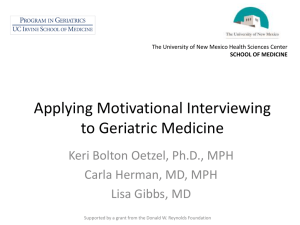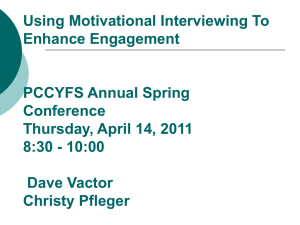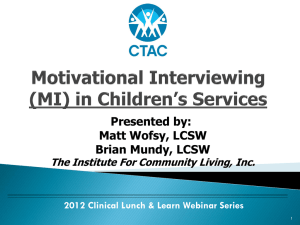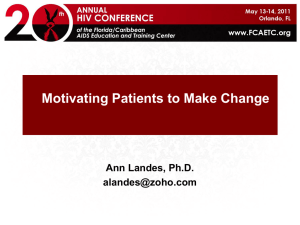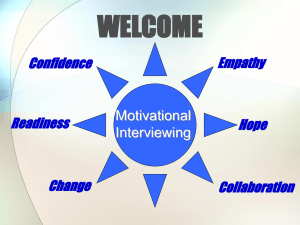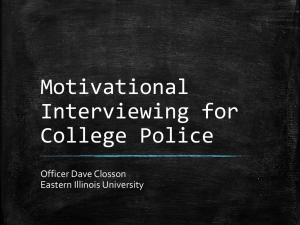Enhancing the Motivation For Change
advertisement
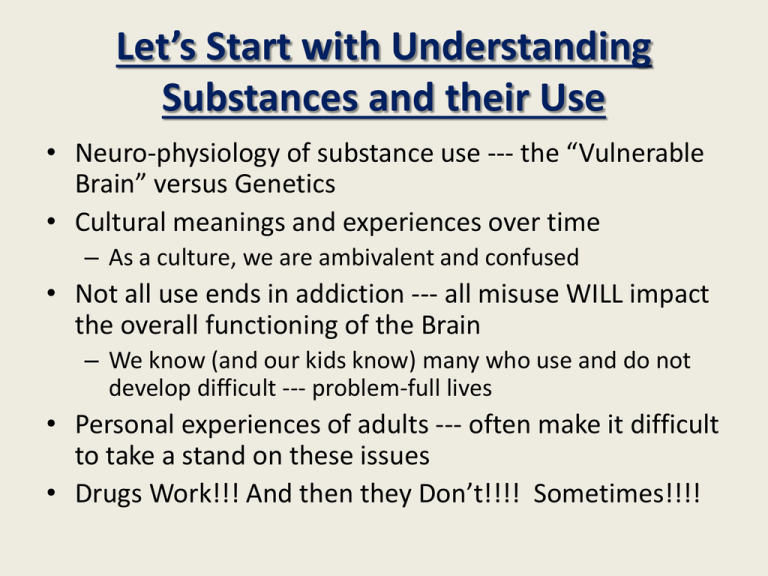
Let’s Start with Understanding Substances and their Use • Neuro-physiology of substance use --- the “Vulnerable Brain” versus Genetics • Cultural meanings and experiences over time – As a culture, we are ambivalent and confused • Not all use ends in addiction --- all misuse WILL impact the overall functioning of the Brain – We know (and our kids know) many who use and do not develop difficult --- problem-full lives • Personal experiences of adults --- often make it difficult to take a stand on these issues • Drugs Work!!! And then they Don’t!!!! Sometimes!!!! Understanding Addiction ASAM New Definition (8/11) • Addiction is a primary, chronic disease of brain reward, motivation, memory and related circuitry. Dysfunction in these circuits leads to characteristic biological, psychological, social, and spiritual manifestations. This is reflected in an individual pathologically pursuing reward and/or relief by substance use and other behaviors. • Addiction is characterized by: – – – – Inability to consistently abstain; Impairment in behavioral control; Craving; Diminished recognition of significant problems with one’s behaviors and interpersonal relationships; and – A dysfunctional emotional response. • Like other chronic diseases, addiction often involves cycles of relapse and remission. • Without treatment or engagement in recovery activities, addiction is progressive and can result in disability or premature death. ABC’s of Addiction – Inability to consistently Abstain; – Impairment in Behavioral control; – Craving, or increased ‘hunger’ for drugs or rewarding experiences; – Diminished recognition of significant problems with one’s behaviors and interpersonal relationships; and – A dysfunctional Emotional response. 4 C’s of Addiction 1. Compulsive engagement in addictive behavior --- preoccupation with it; 2. Impaired Control over the behavior --- even when desired to have control; 3. Continue to engage in addictive behavior despite significant negative consequences; 4. Cravings --- experience dissatisfaction, irritability, or intense craving when the object of the addiction is not available. 4 “Neuro-Networks” Involved in Addiction • Opioid Apparatus (Brain’s natural narcotics --- pain manager/soother/not take it away, dull the conscious experience of it --- endorphins) • Dopamine System (performs incentive-motivation activities (reinforcements for behaviors) as well as reward --- intense emotional experiences of elation/desire)(the Limbic System or Emotion Center of the Brain)---creates “mental cues/cravings/triggers for use • Self-Regulation System (OFC --- Orbitofrontal Cortex) Executive functioning, social behavior, regulation of emotions, impulse control, decision-making. • Stress-Response Mechanisms of the Brain (excessive amounts of the hormone cortisol and/or adrenaline) --becomes reliant on substances for self-soothing and managing stress. Sets stress thresholds… Change and the Addictive Process The Stages of Change Model Contemplation Preparation Action Maintenance Relapse Progress Precontemplation Stages of Change Model Precontemplation Increase Awareness Contemplation Motivate & increase self-efficacy Relapse Assist in coping Preparation Negotiate plan Maintenance Reaffirm commitment Active problem solving Action Implement Plan F/U Termination PreContemplation • Substance using persons are not considering change and do not intend to change behaviors in the foreseeable future. • They are most likely unaware that a problem even exists, that changes need to be made • They may be unwilling or too discouraged to consider change. • Most, at this point, have not experienced adverse consequences or crises because of their use and often are not convinced that what they do is problematic or risky. Contemplation • Awareness is increasing and the individual begins to perceive that there may be cause for concern and reasons to change. • Typically, there is much ambivalence at this stage, simultaneously seeing good reasons to change AND good reasons to not change. • People here are still using, but may be considering cutting back or stopping in the future • It is not uncommon for people to remain at this stage for long periods of time --- held in the grips of ambivalence and fear. Preparation • Here, an individual becomes aware that the advantages of change outweigh the advantages of maintaining the status quo. • Commitment to change is strengthened as the person engages in thinking about the very real possibility of change and altering addictive behavior. • The person actually begins to consider what steps they may need to take in order to accomplish change. • One does an analysis of capabilities, willingness, and desire for change. • They may already be attempting to alter addictive behavior and/or may decide to ask for help. • They begin to consider and choose specific goals and make commitments to themselves to stop using. • Telling others about these developments may be important. Action • A change strategy had been developed and the person is ready and able to engage in the plan. • People are engaged in actively modifying their behaviors, thoughts and relationships with the addictive behavior. • Person is engaged in treatment, or is actively exploring and increasing their sense of personal agency. • People recognize areas of strength as well as areas needed for growth…may participate in skill building groups and/or recovery support groups. • One-to-one therapy may also be a choice for some. • The person is actively not only ;earning about themselves as a sober person, but developing their own skill set and self-efficacy. • It would be important for relevant staff at school to know whether or not an individual is in active treatment…so that a support plan can be negotiated between the student, family, treatment provider and key school staff. Maintenance • Efforts are being made to sustain the gains achieved during the action stage. • People here work to maintain sobriety and prevent recurrence. • Individuals learn to recognize and react to people, places or things that may “trigger” cravings or relapse. • People may choose to participate in some form of recovery support (e.g. AA or therapy) as a way of scaffolding new personal developments. • Relapse is viewed as part of the learning process and not seen as defeat…people re-group and make an effort to move forward. • Important to think about child/student returning to community after a round of treatment --- building adequate supports and strategies are vital both in the home and at school. Relapse • Most people DO relapse at some point, this is not to say we should expect it and support it. • For many, this requires a return to a previous change, for re-evaluation of self and the importance of change. • Relapse also provides valuable information that one can use in order to return to and further sustain change. • Providing support and re-assurance is important, relapse is often experienced as a failure and may contribute to the erosion of belief and self-efficacy. Stages of Change – Parent/Teacher Tasks Stage Tasks Precontemplation Raise doubt – Increase awareness of risks of current behavior Contemplation Tip the decisional balance – Evoke reasons for change; risks of status quo; strengthen self-efficacy Preparation Assist in developing a change plan Action Help person implement the plan; use problem solving and support selfefficacy Maintenance Develop relapse prevention strategies; resolve associated problems Relapse Recycle through earlier stages; alter action plan; avoid demoralization As the degree of mismatch increases between yourself and the person in readiness for change, the likelihood of resistance increases proportionately. Your Viewpoint Other person Differing viewpoints on readiness for change. 10 Processes of Change Coping activities or strategies used by people in their attempts to change Each change process is a broad category of coping activities which encompasses multiple techniques, methods and interventions Two Main Types of Change Processes Cognitive change processes Involve changes in the way people think and feel about their use of substances Behavioral change processes Involve people making changes to their using behavior 5 Cognitive Processes Consciousness Raising Increasing information about yourself and substance use/abuse e.g. - thinking about health effects of substance use - a teacher/parent asking whether you use alcohol or drugs - thinking about physical, social, academic, familial consequences of use - learning more about addiction and the process of addiction (health class, from recovering friends, other trusted resources) Dramatic Relief Experiencing strong emotional reactions to events associated with substance use/misuse e.g. - seeing the effect of substance abuse on the life of a close friend or relative - experiencing a profound consequence either yourself or via a close friend, that really moves you (e.g. a drug overdose, police arrest, death) Environmental Re-evaluation Becoming aware of the impact of the problem behaviour on others e.g. - thinking about the effects of substance use/abuse on your family and friends - recognizing negative consequences and/or symptoms of abuse in other people - increase awareness of how use and the consequences of use --- having been limiting possibilities for life Self-Re-evaluation Affective and cognitive re-experiencing of one’s self and problems e.g. - thinking that you’re no longer happy being a drug/alcohol user...just not worth it any longer - imagining yourself as a non-drug user - the pro’s of not using outweigh the pro’s of using AND the con’s of using outweigh the con’s of not using Social Liberation Noticing and using social conditions that support personal changes e.g. - participation in sober activities - connection with more and more sober friends - active participation in recovery support programs, like AA - new-found ability to stand your ground and pursue life goals without being hindered by substance use issues 5 Behavioural Processes Self-Liberation Belief in your ability to change and commitment to act on that belief e.g. - telling yourself that you can using substances - setting a quit day - telling others you’re quitting Helping Relationships Trusting others and accepting their support in quitting e.g. - asking a friend who used to use for help - working with a substance abuse counselor or getting an AA sponsor - participating in school-based support groups Counter Conditioning Replacing drug/alcohol using with more positive behaviours and experiences e.g. - “Do something else” - develop a wide range of activities that promote physical, emotional and social health - develop a range of coping skills for stress, anger, depression, anxiety, excitement, controlling impulses, etc. - develop a repertoire for solving- problems and making healthy decisions Reinforcement Management Rewards for maintaining sobriety e.g. - the family/friends showering you with praise - buying yourself something you want - telling yourself how wonderful you are --acknowledging and celebrating your achievement Stimulus Control Avoiding or countering stimuli that elicit the problem behaviour e.g. - recognizing behavioural, situational, certain people --- that “trigger” addictive behaviour and having a plan for dealing with them Relationship between Processes and Stages of Change Cognitive change processes help people to move through the early stages of change (e.g. from not thinking about quitting to deciding to quit) Behavioural change processes help people to move through the later stages of change (e.g. from making a quit attempt to staying quit) MOTIVATION AND CHANGE • Let’s look at your own experiences. – What has motivated YOU to do the things you have done? – What has Un-Motivated you? – What has motivated you to make changes in your life --- changes that you did not necessarily want to make, changes that you did not necessarily believe you could make, changes that you initially had no intention on making? Major Components of Motivation • Motivation can be either extrinsic or intrinsic. 1. Activation --- making the decision to initiate certain desired behaviors or setting specific goals. 2. Persistence --- continued effort toward achieving the goal or target behavior, even though obstacles exist. 3. Intensity --- concentration, commitment and energy that is dedicated towards engaging in the objectives and activities that will lead to goal accomplishment. • Inherent challenge in motivating substance users to look at their use and consider making changes: – Motivation is unique and entirely a personal dynamic --- what motivates one person most likely will not work for another --- what is important to the individual? – Motivation for this kind of change, ideally, comes from within --- intrinsic --- in order for the process to be successful. – Inherent in creating motivation is RESISTANCE and AMBIVALENCE --- how we react to or position ourselves in relation to resistance and ambivalence WILL make all the difference. From One Parent to Another “ People only listen to one person --- themselves. And, as a result, they’re only influenced by one person --- again, themselves. So, as frustrating as this may be for a parent who would like to sternly say, ‘You have to stop’, and to have that be enough, the real trick to motivating someone is to get them to convince themselves to make a change for their own good reasons.” What Does Not Work • Telling your child/student about your feelings and how their use is making you feel (shame/blame = defense) • Express out and out anger at the person. • Confront with admonitions to stop --- taking one side of the ambivalence --- may force the other • Humiliation in front of others – being “called out” • Tell them YOUR reasons for why THEY have to stop • Resistance Theory --- the more you push one way, the more they go the other (Paradoxical Impact) • Tough Love --- has been seen in some families to only create a hostile adversarial context --- not very conducive for change…shifts motives for use (possibly intensifying them) What Does Work • Sharing your concern, while reminding them that you know ultimately it is their choice. • Exploring with them reasons they might want to stop, as well as reason why they may not want to stop (Decisional Balance) • Simple statements of love and concern • Establishing clear and reasonable boundaries • Consistently enforcing boundaries with both positive rewards and negative consequences. • Affirming and validating the person’s efforts regardless of use • Exploring the person’s wants, desires, hopes and dreams, intentions and preferred ways of being in the world --- what is most important to you and why. • Affirming the person’s hopes and dreams and collaborating on making them come to fruition --- creating partnerships – may not even be talking about use at this point. And Then… • Given that the Brain and many of it’s key operations for making decisions, regulating emotions, knowing emotions, memory, impulse control, reward circuits, pain management (emotional as well as physical) -- are rendered dysfunctional by substance use and addictive behavior --• You may need to act!!!! • May be able to wait for motivation • Fair but firm boundaries and consequences are more effective than harsh discipline or inconsistent discipline --- in motivating people. • Know where you truly stand on the issues of substance use --- hopefully informed by current research and not influenced by your own history -- attitude check --- mixed messages from parent as well as from teachers. • Be able to communicate clearly your rationale for wanting your child/student substance free (if you are stuck…go to the Brain research --- 15 years old versus 19) MOTIVATIONAL INTERVIEWING • Motivational Interviewing is a directive, personcentered counseling style that enhances motivation for change by helping people clarify and resolve ambivalence about behavior change. • The goal of motivational interviewing is to create and amplify the discrepancy between present behavior and broader goals. Create Cognitive Dissonance Between Where one is now Where one wants to be MI Philosophy 1. Person’s resistance typically is a behavior evoked by environmental conditions. 2. The relationship should be as collaborative and friendly as feasible given the intensity of the situation. 3. Motivational Interviewing gives priority to resolving ambivalence. 4. The teacher/parent does not prescribe specific methods or techniques…kids are free to choose strategies they feel might be most useful. (“what can you do?”) 5. People are responsible for their own progress 6. MI focuses on the person’s sense of self-efficacy. The SPIRIT of Motivational Interviewing 1. Motivation to change is elicited from the person and not imposed . 2. It is the kid’s task, not the teacher’s or parent’s, to articulate and resolve ambivalence. 3. Direct persuasion is not an effective method for resolving ambivalence and increasing motivation to change. 4. The conversational style is generally a quiet and eliciting one. 5. The tescher/parent is directive in helping the client examine and resolve ambivalence. 6. Readiness to change is not an individual’s trait, but a fluctuating product of interpersonal interaction. 7. The therapeutic relationship is more like a partnership or companionship than expert/recipient roles. 3 Fundamental Aspects of the Spirit of Motivational Interviewing ~ACE~ Autonomy --- this is the kid’s life/treatment…they make key decisions. Collaboration --- Partnership Evocation --- the counselor’s/teacher’s/parent’s job is to evoke and elicit motivation for change! The Spirit of Motivational Interviewing Confrontation Collaboration Evocation Autonomy VS. Education Authority Motivational Interviewing Assumptions 1. Motivation is a state of readiness to change, which may fluctuate from one time or situation to another…which can be influenced. 2. Motivation for change does not reside solely within the user. 3. Each person has powerful potential for change. The task of the teacher/parent is to release that potential and facilitate the natural change process that is already inherent in the individual. 4. The way we approach the person is a powerful determinant of resistance and change. An empathic style is more likely to bring about self-motivational responses and less resistance from the person. 5. People struggling with behavioral problems often have fluctuating and conflicting motivations for change, also known as ambivalence. 6. Ambivalence is a normal part of considering and making change and is NOT pathological. 5 General Principles in Motivational Interviewing DEARS Develop Discrepancy Express Empathy Amplify Ambivalence Roll with Resistance Support Self-Efficacy Develop Discrepancy Awareness of consequences is important. The kid rather than the parent/teacher, should present the arguments for change. Exploring and Highlighting the discrepancy between behaviors and goals, motivates change. Change occurs when people perceive a discrepancy between where they are and where they want to be. Examination of the discrepancy between current behavior and future goals/preferences/desires. Ultimately, you want to have the kid themselves present reasons for change. Avoid pushing or arguing with the person in an attempt to convince them of discrepancies in their thinking. Develop Discrepancy • The counselor/parent/teacher seeks to create and amplify, from the kid’s perspective, a discrepancy between present behavior and his or her broader goals and values until it overrides the inertia of the status quo. Develop Discrepancy Explore goals and values with which substance use may conflict: Long term recovery goals Values Dreams Past preferred activities Admired people Develop Discrepancy • Person’s verbalization of negative consequences amplifies discrepancy. – Payoff matrix/decisional balance exercise Using Substances Not Using Substances Advantages Disadvantages Decisional Balance • Decisional balance is the importance a person gives to the perceived advantages (pros) and disadvantages (cons) of smoking, and of quitting • An individual’s motivation to change is affected by his/her decisional balance Expressing Empathy Convey a your appreciation that person’s behaviors make sense given their context and the their current way of thinking about them. • • • • • • • • Acceptance facilitates change Ambivalence is NORMAL Skillful reflective listening is fundamental. Warmth Openness Personal Value Understanding Which means managing our own feelings, reactions, wants and desires for the student/child Express Empathy Tips… Good eye contact Responsive facial expression Body orientation Verbal and non-verbal “encouragers” Reflective listening/asking clarifying questions Avoid expressing doubt/passing judgment Amplify Ambivalence Ambivalence is Normal. Exploring ambivalence helps remove obstacles. Resolving ambivalence moves towards behavior change. “Ambivalence cannot be forced into resolution --It must be amplified and explored so that its fruits can be used to feed the process of change”. (Miller) Roll with Resistance Use momentum to your advantage. We do not want to fight the resistance. Resistance is not directly opposed. Avoid arguing for change and/or direct opposition. New perspectives are invited but not imposed. The student/child is a primary resource in finding answers and solutions. Resistance is a signal to respond differently. Support Self ~ Efficacy Believing that change is possible is an important motivator. Research shows that the our belief in the other’s ability to change --- can be a significant determinant of treatment outcome, “a selffulfilling prophecy”. Refers to a person’s belief in his or her ability to carry out or succeed with a specific task. Six Key Elements in the Process FRAMES • Feedback: Provide useful feedback based on what you see and what you notice in terms of consequences. People are motivated to change when they get feedback on their personal situation. • Responsibility: Rather than telling the child what she can and can't do, emphasize personal responsibility and freedom to choose. • Advice: Give specific recommendations about how using patterns can be changed. • Menu: Provide the person with options, such as reducing drinking or abstaining. This allows the person to be involved in the decision-making process and thus more willing to change. • Empathy: Being warm, supportive, sympathetic, and attentive will be more motivational than being confrontational and aggressive. Show an understanding of the person's goals and the role of alcohol/drugs in her life. This will help you identify ways to help her make changes. • Self-Efficacy: The person must believe that she can change. Convey the message, "You can change." Encourage optimism. What to Do for Educators 1. 2. 3. 4. 5. 6. 7. 8. 9. Approach your students with empathy and concern. State your intentions from the onset. Be prepared to point out specific situations and specific behaviors that have shaped your concern for the student. Do not confront or blame/shame --- rather share your thoughts. Ask open-ended questions, attempting to gain a better understanding as to what may be going on in the student’s life. Listen --- hold your advise for now --- Listen Attempt to ascertain student’s biggest worries or concerns about current situation. Ask for advise from the student --- “what would they think might be a good next step in order to address these issues?” Advocate and connect student with appropriate helping staff within the school. What to Do’s for Parents 1. 2. 3. 4. 5. 6. 7. First and foremost, develop a clear and consistent position on substance use in your household. Your position should be based on your values and one that you and your partner can and will stand by. Develop skills and rituals for communication long before the crisis…it is very difficult to have positive communication once the crisis sets in and there is no history for interacting these ways. LISTEN before you act --- take time to digest before you react. Avoid power struggles – tends to strengthen resistance against change. State your concerns and evidence calmly, caringly, attempting to avoid anger, blaming, interrogation, etc. Seek help for yourselves prior confronting your child --- often having a third party help you wrap your mind around all this, could be useful in developing a plan of action versus a plan of attack. Ultimately, you may have to be prepared to act. The Pro’s and Con’s of Forced Intervention/Treatment • Pro’s – Need to act to disrupt addictive cycle – Once in treatment, child could become motivated as a result of being engaged by staff and other participants – Child recognizes parents/teachers as authorities that will act in order to ensure safety – Motivation as a dynamic process --- starts with creating an incentive or reasons for change --- being in treatment may provide either positive or negative reinforcement for motivation • Con’s – Mismatch between where the child is in terms of stage of change and the action being taken – Strengthens ambivalent position against change, thus strengthening resistance for change – Intervention on your part is viewed as and experienced as a betrayal – Adolescent learns how to negotiate the treatment process and continues to use regardless of efforts to intervene The people in this room are some of the greatest motivators around…. You are teachers, coaches, parents, collaborators on many projects with many others…. How do you inspire? Create Incentives? Let’s Brainstorm What’s Worked for You?
